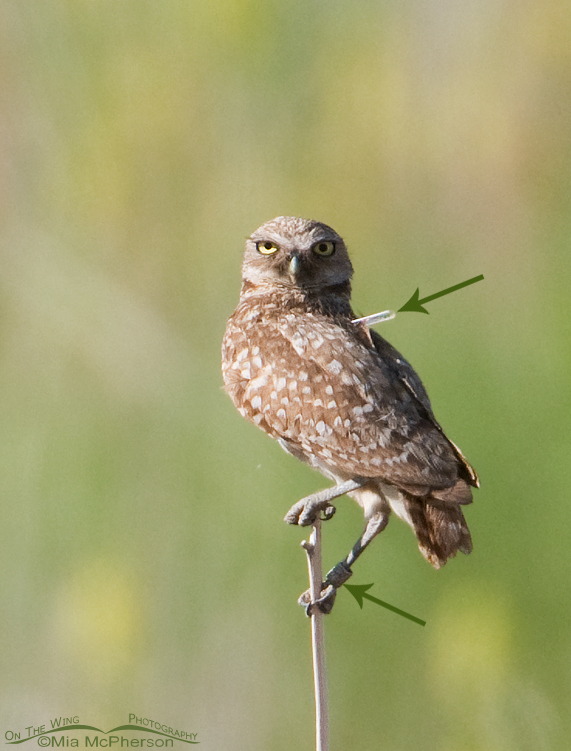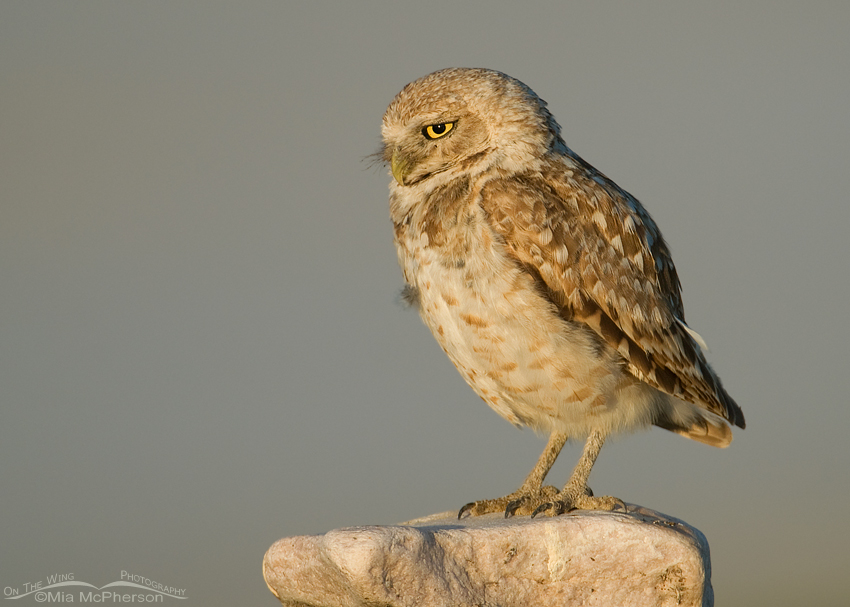 Banded Burrowing Owl adult with telemetry device?
Banded Burrowing Owl adult with telemetry device?
Anyone who follows my blog knows I adore Burrowing Owls, I am totally fascinated by these small “Clowns of the Desert” and could spend hours & hours watching and photographing them.
Last week while taking a quick look at a burrow I have been watching I noticed several chicks above the ground and one adult that was perched high up on a dried out sunflower stalk way off in the distance. I took a few quick shots of the adult and I am glad I did because with my naked eye I couldn’t see that someone has banded the adult and it appears that a telemetry device has also been attached to the adult. You might wonder why.
Western Burrowing Owls populations are declining, human population explosion and subsequent urban development plus habitat degradation has reduced Burrowing Owl populations by 60% and that number is still rising. Burrowing Owls are a Species of Concern in Utah and we should be concerned if we want to stop their population decline.
 Adult and juvenile Burrowing Owl
Adult and juvenile Burrowing Owl
The reason for the bands on the Burrowing Owls on Antelope Island is research on their populations and the telemetry device will be used to track their migration.
As a bird photographer I’m not exactly thrilled about the “bling” the owls are wearing but as a person concerned about their conservation and their future I do understand why the research is needed.
Western Burrowing Owls are declining throughout their range and we need to act on it now.
For facts on Western Burrowing Owls take a look at these sites:
Burrowing Owl Conservation Network
Center for Biological Diversity
Mia
*I am still away, thanks for your comments on these posts and please feel free to share this with your family & friends.



I just love these owls, and the barn owls too… *sigh* we have to try as hard as we can to save them all. they balance the ecosystem!
Thank you Nicole, we do need to save the owls because they are vital to natural balance in nature.
Wonderful photos, Mia! It’s so sad their numbers are declining.
Thank you Charlotte.
nice serie, and it s always interesting to repport observations to specific organisation for it, each time there a ring or something else like you have seen
for example, here i m repporting flamingos rings i can watch during my way, usefull for knowing moves for somes birds.
thanks to larry to for extra explication
have a nice day ☼
Thanks Eric, I always try to report banded birds because resightings can provide valuable research information to those who are doing studies.
Larry is a walking encyclopedia about Western Burrowing Owls and the issues they are facing here in the American west. I hope we can do something about the declining numbers of Burrowing Owls before they are on the edge of extinction.
I didn’t know Antelope Island was tracking them. Good idea. Thanks for sharing that information and the network.
My pleasure Mavourneen.
Thanks for posting this Mia. As a member of the Burrowing Owl Consortium and a staff member of the Burrowing Owl Conservation Network I am concerned about every single Burrowing Owl. One way people can help us is to email any Burrowing Owl sightings to us at- Sightings(at)Burrowing-Owl(dot)org
I’m glad to see a telemetry study being done on these beautiful birds because one of our biggest problems is not knowing where the owls winter and their migration routes. There are some locations where Burrowing Owls are permanent residents but many migrate for the winter to temporary homes, then return to the same breeding grounds to breed in the Spring. For more information on how to email a sighting, go to http://burrowingowlconservation.org/sighting.html
Love that last shot of the Juvenile all fluffed up atop the sage!
Larry, as you know I often try to bring information to my viewers about the plight of our Western Burrowing Owls to my readers attention. Alone we might not be able to do much about this problem but united we certainly can, like stopping developers from plowing under their burrows for yet another suburb filled with McMansions that destroy the habitat for all wildlife.
Thank you for providing more information about resightings and the Burrowing Owl Conservation Network.